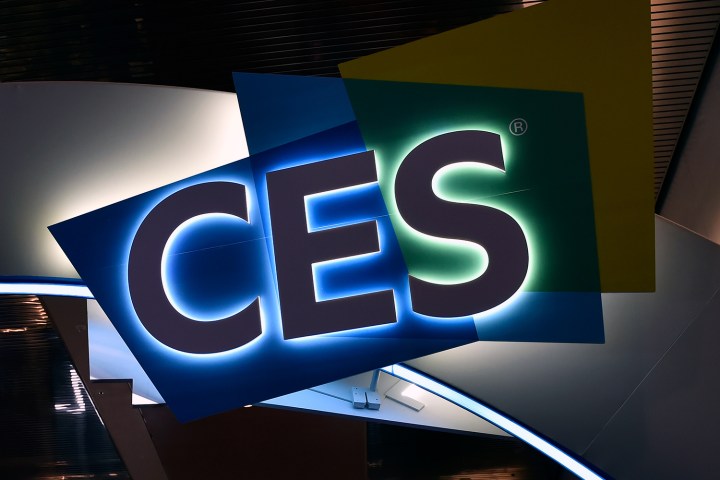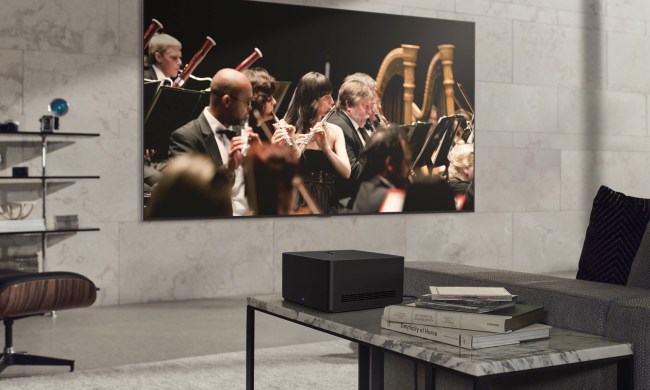
With over 4,400 companies exhibiting new products and services, CES 2019 was a gadget lover’s paradise, and a window into the future of … well, everything. Anyone who described 2019 as “an off year” simply was unable to see the future in front of their face. Making sense of it requires a small army of the savviest analysts you’ll find anywhere, so Digital Trends writers and editors walked hundreds of miles and spoke with scores of companies. Along the way we were dazzled by laptops thin enough to disappear in a backpack, TVs that magically unroll from a box on command, and futuristic digital binoculars that made us wish for a 2019 remake of Rear Window. And we visited the metaverse. Yes, the metaverse.
Oddly enough, it was a fake burger that took our award for the top tech of CES. This is no mere recipe, of course, but food engineering and science at its finest. Impossible has loaded its next-gen burger with the iron-carrying molecule heme, which is part of what gives meat its distinctive flavor. It’s also conspicuously absent in all the faux meat you’ve tried and hated. Impossible’s news is everything amazing about CES wrapped up in a bun, neatly underscoring the way that tech touches everything in our lives.
Beyond just burgers, we walked the Las Vegas Convention Center aiming to tease out the trends that will shape the year ahead in technology … and maybe play with some cool stuff along the way. Here’s what we learned, and how it will affect the products and tech that will shape your life in the year ahead.
Home Theater
This was a huge year for TVs at CES, with real innovation and big leaps forward. TV makers are pushing the envelope like never before. For starters, there’s Samsung’s 219-inch “The Wall.” It’s a Micro LED TV, a new type of TV technology that has us amazed. It’s emissive, like OLED, but unlike OLED it uses only red, green, and blue LED pixels, so not only can it deliver true black levels, but it is incredibly bright and colorful. Of note: This is a modular system that can be assembled in any size or shape you want. Samsung showed off a 75-inch variant, but imagine a variety of new shapes and sizes. TVs: They aren’t just rectangles anymore!

We also saw LG’s Signature OLED TV R. The R stands for roll-up or, as we like to call it, “roll-ed.” The TV emerges from a long rectangular box like a phoenix from the ashes, and when you’re done watching, it rolls right back down, out of sight. If it’s a sharper picture you’re after, 8K sets were everywhere from Samsung, LG, Sony, Panasonic, and others, proving that the new buzzword will remain on lips and minds in 2019.
And one of the most intriguing new trends to come out of Las Vegas this year comes from a technology that’s not new at all: An audio protocol known simply as WiSA that transmits crystal-clear, high-resolution audio wirelessly to stereo, surround, or even Dolby Atmos speakers. WiSA not only offers lag-free, high-quality sound, but since it’s brand agnostic, it can be implemented by virtually any audio brand. The technology has been kicking around for years now; we first reported on it at CES 2013. In 2019, expect it to take off.
Mobile
At every major press conference and every big booth, two characters were front and center: 5G. But not much else. While conversation around 5G was unavoidable, there were few actual product announcements: a new router, a demo phone in the Samsung booth, and so on. That’s because most of the actual products are being saved for Mobile World Congress, the mobile trade show that’s just around the corner. Still, the energy and excitement around 5G was unmistakable. In years past, discussions felt like hype. This year, it felt like promise — despite revelations that AT&T was faking 5G on millions of 4G phones, which it believes are nearly fast enough. 5G will indeed show up in 2019, but you’ll need to tune in after CES to see the good stuff.
Meanwhile, the mobile industry did have a few tricks up its sleeve, notably revelations from Samsung that it plans to release a foldable phone in first half of 2019. And fresh demonstrations from a little-known Chinese company called Royole of a home-grown folding smartphone of its own. Clearly, the very shape of phones in the future is about to take a dramatic shift.
Smart home
Smart home devices mean everything from doorbells to dishwashers, but one product category stood out for us at this year’s CES: toilets. Yep, CES 2019 was flush with toilets, some featuring internet connected features, voice assistants, and more. Eep!
Amazon Alexa rocked CES 2019 too. Amazon sold millions of Echo and Dot smart speakers during the 2018 holiday season, extending its reach in the U.S. and around the world. During CES 2019, the Seattle company introduced new products, features, and services that support Key by Amazon, (formerly Amazon Key); announced new gear from the Amazon-owned Ring brand; and presented piles and piles of new products that are Alexa compatible and or have Alexa built in.

But Google didn’t let Alexa do all the talking. Google Assistant came to CES 2019 loaded for growth with three times more exhibit space than last year and tons of news: upgrades to Google Assistant on smartphones, the ability to check into a flight with just your voice, Assistant in Google Maps at last, and more. Which company won? In the end, there is one clear victor: consumers.
VR and AR
There weren’t a ton of exciting VR headsets on display, but the three that most impressed us gave reason to think that VR is about to have its moment. For starters, the Oculus Quest could very well be the future of VR: It doesn’t require a fancy gaming PC to work, and it’s quite a bit more powerful than earlier offerings, bringing it closer to PC VR experiences that have been mostly reserved for serious enthusiasts up until this point. Meanwhile, The HTC Vive Pro Eye is essentially the same headset that launched in 2018, with one crucial additional feature: Tobii eye-tracking. This tech lets users control in-game experiences using eye movements. The future is here! And the Pico G2 4K aims to bring 4K resolution to virtual reality, merging buzzwords and perhaps showing us where the industry is going.
Meanwhile, AR and VR gadgets proved there’s still room for innovation in this space. NordicTrack unveiled a VR Bike that comes bundled with an HTC Vive headset. With it, you’ll be able to play games designed specifically for the VR Bike; the difficulty increases based on how much you exert yourself. And Cybershoes act as a supplement for your existing VR setup — and your existing shoes. Slip them over a pair of standard shoes and walk much like you would in real life. Your movements are transferred into the games you’re playing.
Laptops
CES 2019 was packed with announcements about new processors and graphics cards, but only one was present in laptops actually at the show. The Nvidia RTX 20-series mobile GPUs, the most powerful consumer GPUs ever made. Nvidia launched these new cards with an impressive 40 entries from laptop brands. That includes Omen, Alienware, Razer, MSI, ROG, Predator, and more. What’s it mean? Your next laptop will bring a new level of PC gaming.
Meanwhile, bezels are out – and so are 2-in-1s. With shrunken bezels and small overall footprints, the next generation of laptops are more stylish than ever, encapsulated by the new Dell XPS 13, which looks great and solves a long-running issue with the product: the nostrilcam. We’ve entered a new age of sleekness.

OLED laptops briefly appeared at CES 2016 before disappearing, canceled too soon like your favorite TV show. Now, a fresh group of OLED laptops were announced at CES 2019, many of which are scheduled for release later this year. A couple were even shown off at the event. These bring ultra-rich colors and super dark black levels to the content on your screen, which – let’s face it – is Netflix and Hulu as much as it is Excel and Outlook, right?
Cars
Important car-related announcements were made by century-old automakers, tech giants, and game-changing startups no one has heard of before. Connectivity, autonomy, and electrification reigned supreme once again, with varying degrees of realism and feasibility. While full driving autonomy remains years away, CES confirmed 2019 will be the year of in-car connectivity.
Audi harnessed the power of virtual reality (VR) to make a significant breakthrough in in-car entertainment, while Qualcomm wants to finally make vehicle-to-everything communication a reality. Its 9150 chipset should bring the technology to cars at last, and should hopefully save lives. But humans will continue to drive and be driven in cars for decades, and so Qualcomm and Harman were among the companies displaying what the cockpit of the near future could look like. If you ask us, it looks glorious. We welcome our robot chauffeurs!
Meanwhile, Bell unveiled a full-scale prototype of a vertical-takeoff-and-landing (VTOL) air taxi at CES, and Harley-Davidson showed off the production version of its first electric motorcycle ever, coming to dealerships this year.
Health
Technology is supposed to make our lives easier, but the health and wellness sector is a bit of minefield. It’s not always easy to find the gadgets and services that are based on sound science, things that can actually alleviate suffering and improve lives because there’s a river of snake oil out there.
That said, CES welcomed enough tech and science innovations to fill your medicine cabinet, and then some. We were wowed by Testcard, which mails pregnancy, UTI (urinary tract infection), and glucose level testing strips to you at just $4 a pop. Just pee on the strip, then check the app. A redesigned Quell — a small unit you wear on your leg that relieves sensations of pain — may spell relief for chronic sufferers. The second-generation device is 50 percent smaller, but up to 20 percent more powerful than its predecessor. The app has also been redesigned and now includes a higher degree of personalization to help you effectively manage your pain, and new therapy options are coming later this year.


